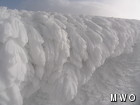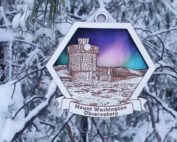Relative Humidity
2008-03-17 14:20:49.000 – Steve Welsh, IT Observer
Rime Ice
One of the things you notice whilst living on the top of Mount Washington in winter is how dry the air is. Over the course of a week long shift up here your skin dries out and cracks. Typically the air inside the building, at this time of year, has a relative humidity of around 10% to 15%, which, is kind of strange considering we are in the fog most of the time with the humidity outside at 100%. So what’s going on? It turns out that warm air can hold far more moisture than cold air so the air outside the building can be totally saturated with moisture but the actually amount of water vapor it holds is really very low. Bring that air inside and warm it to 70 degrees and voila you have very dry air indeed.
One of the key components of the observations we make up here every hour is the dew point temperature. This is really a form of humidity measurement. The dew point temperature is defined as the temperature at which the air must be cooled, at constant pressure, before condensation (or dew) will form. Remember that colder air can’t hold as much water vapor as warm air, so if you cool the air, as often happens at night when the sun goes down, you’ll end up with dew forming on exposed surfaces such as grass. So the dew point temperature, as we report every hour in our observations, can be considered as the temperature you’d have to cool the air to form condensation. When the dew point temperature is equal to the air temperature you’re basically in the fog, however, if the dew point temperature is considerably lower that the air temperature then you’re in dry air.
For most people humidity levels from 35% to 45% are considered comfortable, much below 30% and it becomes too dry and above 60% it becomes oppressive – think of hot muggy summer days in New England.
The picture shows rime ice, which, is formed when super-cooled saturated air, in other words freezing fog, freezes on contact with surfaces. So 100% humidity can have its good side.
Steve Welsh, IT Observer
2025 Holiday Gift Guide
2025 Holiday Gift Guide By Brandi Malloy There’s something magical about Mount Washington, especially during this time of year. Thanks to our online store, you can bring a little piece of that magic home—
Inside the Weather Room: How Mount Washington Observers Monitor the Atmosphere
Inside the Weather Room: How Mount Washington Observers Monitor the Atmosphere By Karl Philippoff As a weather observer on Mount Washington, we take our hourly observations on the observation deck, usually heading out between
From Weather Observer to Intern, to Observer Again
From Weather Observer to Intern, to Observer Again By Madelynn Smith As I rode in the backseat of our Obs van up the Auto Road for the first time as a full-time employee at






